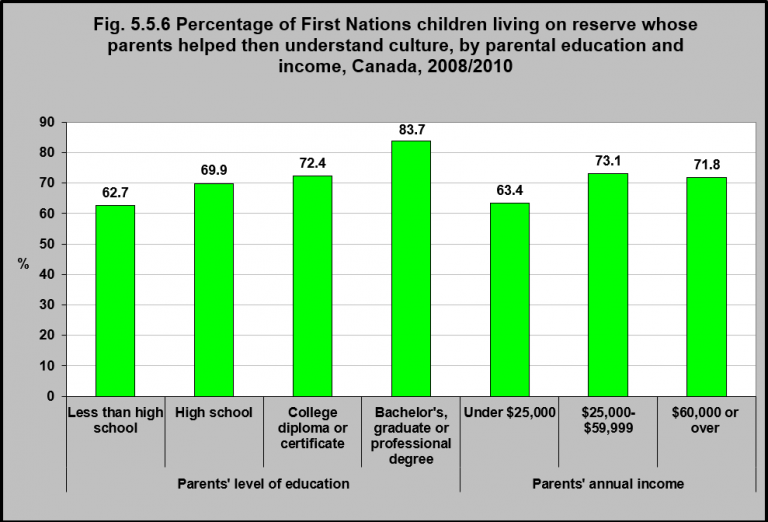Percentage of First Nations children living on reserve whose parents helped then understand culture, by parental education and income, Canada, 2008/2010

Source: CICH graphic created using data adapted from the First Nations Regional Longitudinal Health Survey (RHS) 2008/10, National report on adults, youth and children living in First Nations Communities. https://fnigc.ca/sites/default/files/docs/first_nations_regional_health_survey_rhs_2008-10_-_national_report.pdf -accessed August 5, 2017.
In 2008/10, First Nations children on reserve living with parents who had higher levels of formal education were more likely to have parents who helped them understand their culture, than those living with parents with lower levels of formal education.
Sixty-three percent of children living with parents with less than a high school education had parents who helped them understand their culture, compared to 83.7% of those living with parents with a university degree.
Sixty-three percent of First Nations children on reserve living in households where the parents’ annual income was less than $25,000 had parents who helped them understand their culture.
This compared to 71.8% of children living in households where the parental income was $60,000 or more.
Implications
Culture is an important component of healthy child development. Culture contributes to the development of a sense of identity and belonging, which in turn is important for an individual’s psychological functioning, relationships with their peers, and academic achievement, as well as for the wellness of families and communities.1 Language is the means by which culture is conveyed and preserved. As primary caregivers, parents play an important role in conveying and preserving culture, especially in the early years of a child’s development. The association between higher levels of parental education and income with a greater transmission of cultural knowledge among First Nations children, highlights the importance of developing strategies aimed at addressing education and employment gaps among First Nations people, as well as strategies to increase cultural education programs for children.
1Lalonde, C.E. (2006). Identity formation and cultural resilience in Aboriginal communities. In R.J. Flynn, P.M. Dudding, & J.G. Barber (eds.). Promoting resilience in child welfare (Ch. 4).. Ottawa, ON: University of Ottawa Press.
